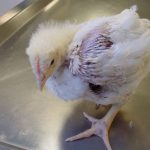Staphylococcosis is an opportunistic infection that occurs mainly at the locomotor level. It is responsible for decreases in zootechnical performance, slaughterhouse seizures and food-borne diseases.
The disease agent and its pathogenicity
Staphylococcosis are mainly caused by Staphylococcus aureus, but others are sometimes found (S. sciuri, S. lentus, S. saprophyticus, S. epidermitis, S. cohnii, S. gallinarum). S. aureus is a Gram-positive coccus, which in microscopy forms clusters (grapes). S. aureus is easily cultivated on blood agars (colonies visible in less than 24 hours at 37°C). Be careful, cultures longer than 24 hours may take on a Gram negative aspect. S. aureus have β-hemolytic, positive catalase and positive coagulase properties. Most other staphylococci are coagulase negative (but they are generally low pathogenic in poultry).
The pathogenicity lies in the production of many toxins and lytic enzymes.
Impact on public health
S. aureus is a collective foodborne disease agent. Carcasses are contaminated at the slaughterhouse, either by endemic strains of the slaughterhouse (avian origin) or by workers’ hands. Methicillin-resistant strains have been identified in slaughterhouses in some countries. There is concern about the risk of transmission of resistance genes between avian and human species. Humans can also become infected through skin trauma.
Epidemiological data
Staphylococci are ubiquitous and natural hosts of skin and mucous membrane flora. All avian species are susceptible to staphylococcosis. Staphylococci are relatively resistant, especially in exudates. Incubation is relatively short (from 48 to 72 hours).
Infections occur following a breakdown of the animal’s physical and immune barriers: inflammation of the mucous membranes, skin lesions (maceration, sharp objects, surgical interventions such as clipping and declawing, parenteral vaccinations, poor umbilicus closure) or immunosuppressive infections (Gumboro disease, infectious anemia, Marek’s disease).
Clinical manifestations of the disease
Symptômes
- They are indicative of the bacterium’s entry route. Most often, it affects bones, joints and tendon sheaths in the legs. The picture is therefore oriented towards locomotor disorders.
- First we observe animals with ruffled feathers, lame and feverish. Then comes severe depression and death in case of sepsis. Surviving animals have swollen joints and have difficulty standing upright. Mortality can also occur after an underlying evolution for several weeks as osteomyelitis.
- More generally, there are decreases in growth performance (difficulty in moving to food sources) and egg laying.
Lesions
- Appareil locomoteur : ostéomyélites (zones de lyses avec un exsudat caséeux, qui fragilisent les os) au niveau du fémur proximal et du tibiotarse proximal principalement. Lors de la désarticulation de la hanche, on pourra à l’autopsie observer des ruptures de la tête fémorale. Outre les os longs il peut y avoir atteinte vertébrale. On constate aussi des synovites et des arthrites. Les troupeaux de reproducteurs sont souvent concernés par des arthrites tibiotarsiennes et des phalanges. Enfin, on peut également observer des abcès au niveau des pâte appelés « bumblefoot » en anglais.
- Musculoskeletal system: osteomyelitis (areas of lyses with caseous exudate, which weaken the bones) mainly in the proximal femur and proximal tibiotarse. During hip disarticulation, ruptures of the femoral head may be observed at autopsy. In addition to long bones, there may be vertebral damage. There are also synovitis and arthritis. Breeding herds are often affected by tibiotarticular arthritis and phalanges. Finally, bumblefoot cans also be observed.
- Tegument: in infectious anemia S. aureus may be involved in the process of gangrenous dermatitis. In addition, staphylococci can lead to the formation of abscesses on the legs and in particular complicate the sternal bursitis*.
- Viscera: infection via the umbilicus can cause lesions of omphalites. Septicemic processes can lead to the appearance of necrosis points on the liver.
- In turkeys, an osteomyelitis and green liver syndrome is described at the slaughterhouse where staphylococcus can be detected.
* The sternal bursitis corresponds to a subcutaneous inflammatory reaction at the breasts. It is the weight of the animal transferred to the sternum and friction with the litter (especially if it is degraded) that leads to this reaction. The blister formed by the inflammatory fluid can then become infected, especially with staphylococci.
The diagnosis
Highlighting
It is done by culture on blood agar from exudates or from injured organs and by standard biochemical tests (catalase test, coagulase test).
Differential diagnosis
It is made with septicemic germs (E.coli, P.multocida, S.Gallinarum), involved in lameness (M.synoviae, reovirus) and generally those involved in hatchery and during traumatic superinfections.
Disease prevention and control
Prevention
Staphylococci being ubiquitous, the main focus will be on preventing traumatic causes and immunosuppressive diseases (vaccination against Gumboro disease and infectious anemia). A good maintenance of the quality of the litter is essential.
Treatment
Antibiotic treatments are generally effective, provided that the treatment is well targeted after an antibiotic susceptibility test has been performed.







